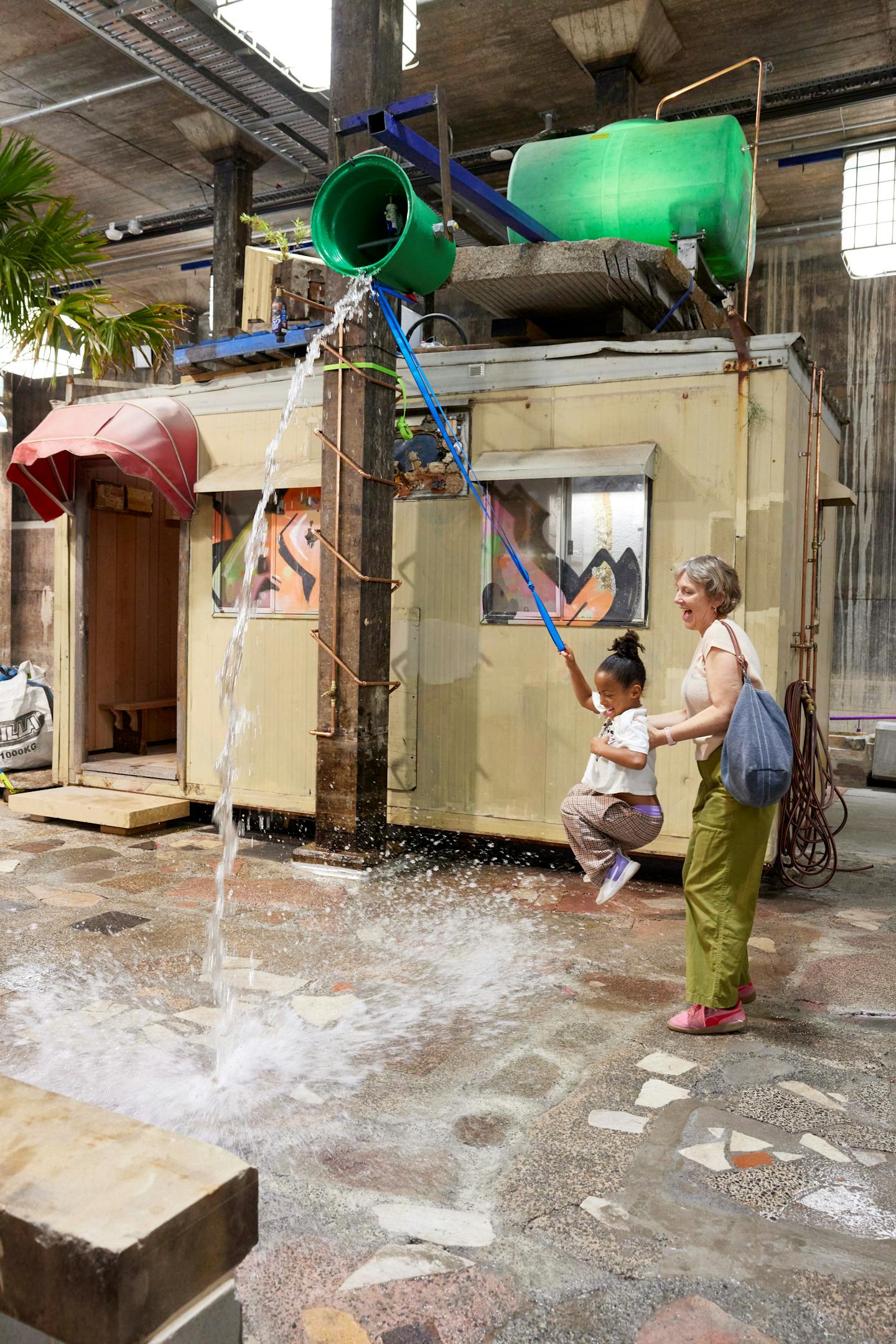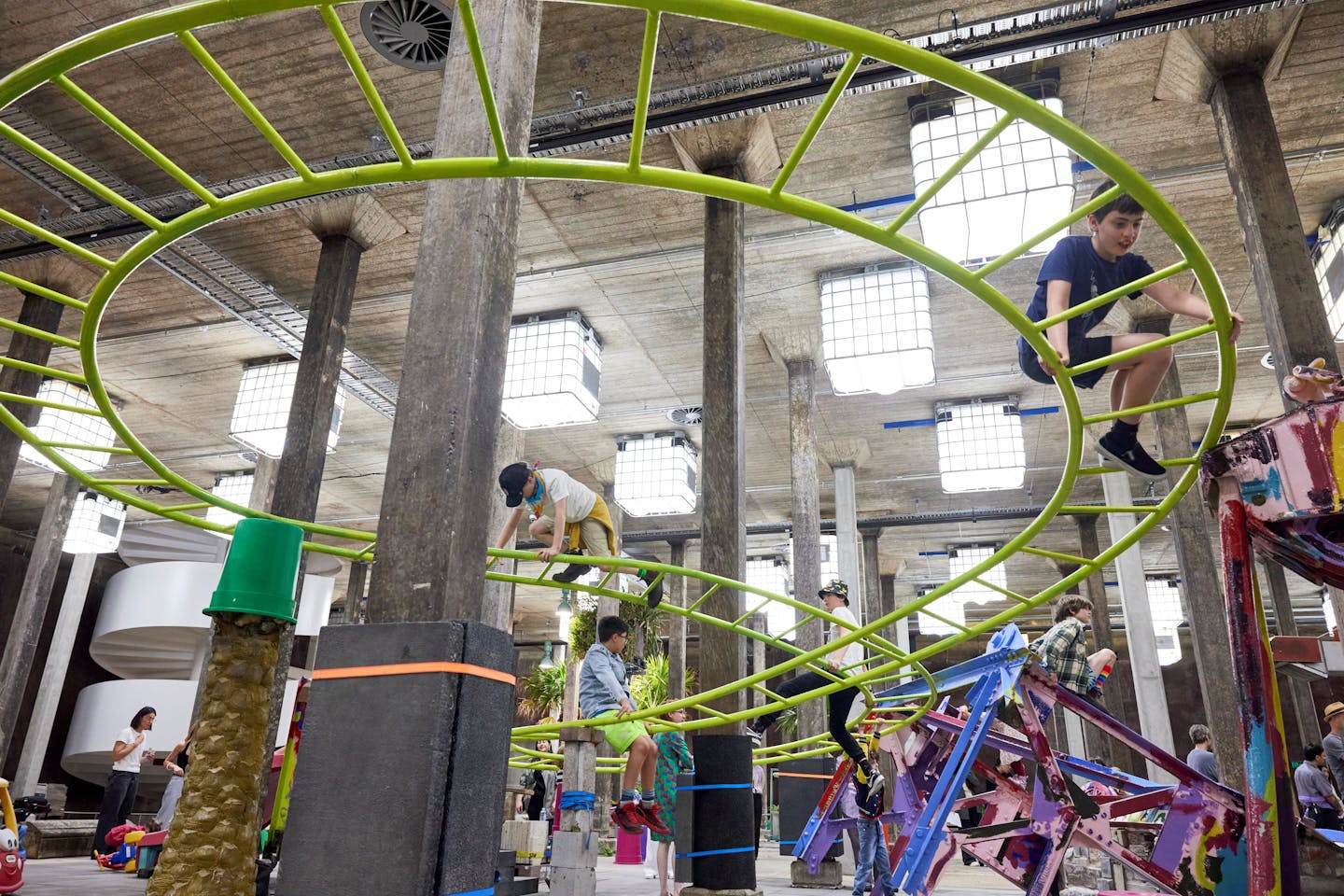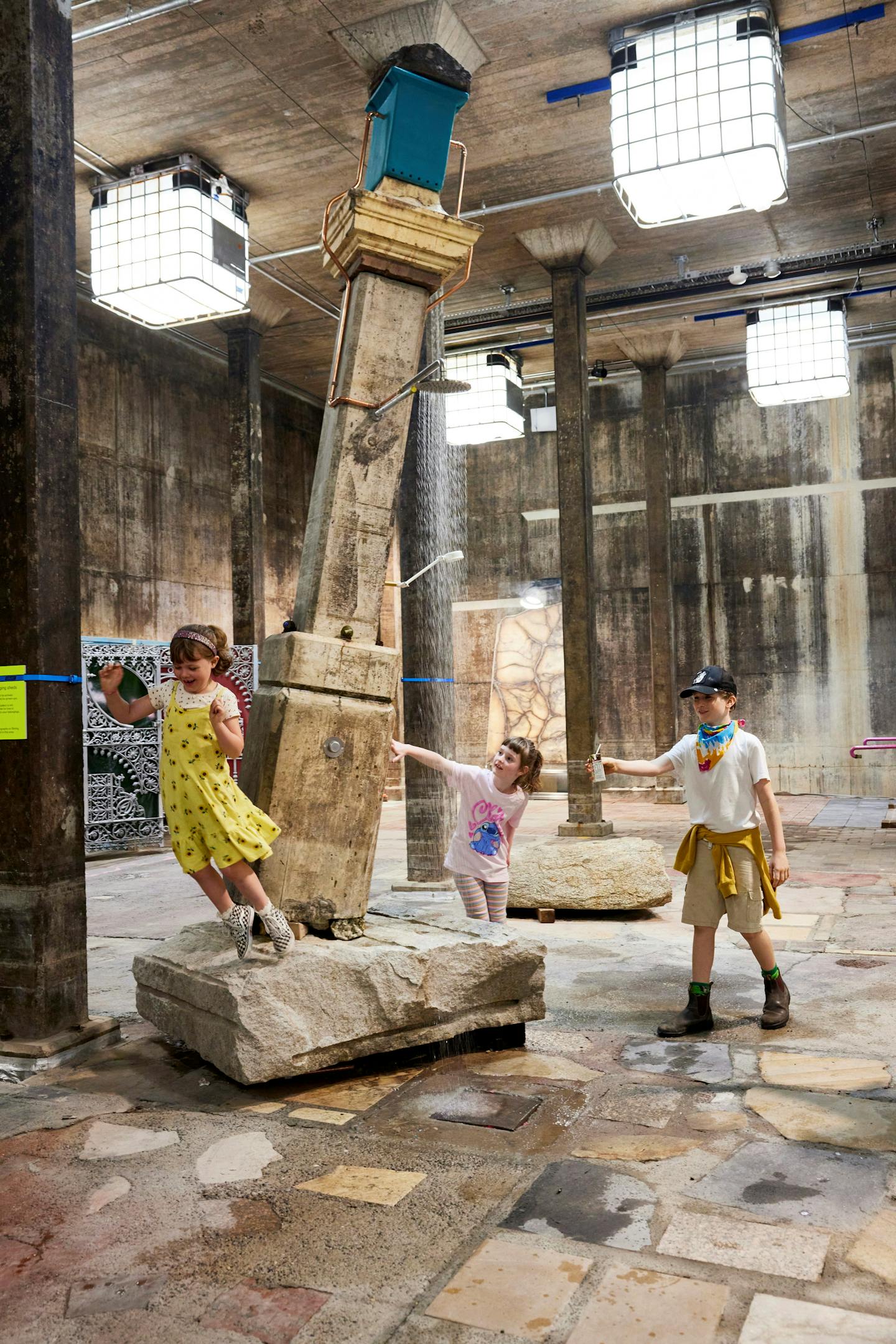Children’s screams echo off concrete walls as they navigate bright-painted monkey bars. Families huddle around a sausage sizzle. Teenagers lounge on borrowed towels near a palm grove. Washing machines hum quietly in the corner.
But we are inside the Art Gallery of New South Wales.
Mike Hewson’s The Key’s Under the Mat is one of the most ambitious and intelligent works of public art created in Australia in recent years.
What makes this work so remarkable is how completely it succeeds on multiple registers simultaneously. It’s a functioning neighbourhood park, a sculptural tour de force, and a sophisticated meditation on what we mean by “public space”.
Hewson has thought through every detail with extraordinary care. Inside the gallery’s cavernous underground tank gallery, brass spoons are hammered into custom concrete pavers. Steel rails are hand-painted rather than powder-coated, giving them a casual, approachable quality. Trinkets and tiles are embedded throughout like hidden treasures. Look down at the ground and the pavers read like abstract paintings.
The craft is exquisite – but it doesn’t announce itself. Instead, it creates an environment where people feel genuinely welcome to cook, play, do laundry and linger.
And they do. Watching families engage with this space – not in hushed gallery tones but with the comfortable ease of a neighbourhood park – reveals the work’s most radical achievement: most people using it (primarily children under 12, on the day I visit) have no idea they’re in an artwork.
‘Hopeful embellishment’
The work emerged from the artist’s experience of the 2011 Christchurch earthquake. Witnessing the collapse of structures that had seemed permanent, Hewson became fascinated by provisional repair, improvised solutions, and the community-building gestures that emerge from disaster.
Hewson’s subsequent projects have celebrated what curator Justin Paton calls “defiant repair and hopeful embellishment”: the beauty of making-do with care and resourcefulness.
The Key’s Under the Mat brings this ethos into dialogue with institutional space in ways that are both generous and thought-provoking.

The vast tank at the Art Gallery of NSW was built urgently in 1942 to hold fuel for the war effort, then abandoned for decades before being drained, cleaned and opened to the public in 2022. Here, it becomes the perfect container for Hewson’s vision of repurposed, reimagined public infrastructure.
The work’s intelligence lies not just in what it provides, but in what it reveals about the nature of “public” space itself. The gallery is a public institution, and entry is free. Yet accessing the tank still requires certain conditions: geographic proximity, availability during gallery hours, cultural confidence to enter a major art institution, and the knowledge that this remarkable space exists at all.
By creating functioning public amenities – laundromat, barbecue, playground – Hewson makes visible something we often overlook: “public” always comes with conditions. Laundromats require proximity, mobility and often money. Park barbecues require time, transport and sometimes booking systems. No public space is universally accessible, even when it’s genuinely free and open.

The project illuminates this with remarkable clarity. In trying to create the most welcoming, functional and generous public space possible within a gallery, Hewson reveals both what institutions can achieve and where their reach inevitably stops. It’s a paradox the work holds lightly but meaningfully.
Institutional critique; joyful amenity
There’s something profound about how the work operates for different audiences.
Children climb and play without needing to understand they’re experiencing art. Art-literate visitors notice the handmade pavers, the embedded spoons, the deliberate aesthetic choices.
Both experiences are valid; both are intended. The work makes room for multiple ways of engaging – from pure use to deep analysis.
This multiplicity extends to a question Hewson leaves deliberately open: should there be more interpretive signage explaining the work’s intentions and extraordinary craft? The current approach lets the art disappear into life, functioning without demanding recognition. But it also means the labour and thought remain visible primarily to those already versed in contemporary art’s vocabularies. There’s no single right answer – and the work’s refusal to choose feels intentional.
Hewson has described children as his “first ambassadors and interpreters” for this work. Watching kids genuinely inhabit the space confirms his instinct. They don’t need permission or explanation – they simply use what’s there.

The Key’s Under the Mat achieves something rare: it is simultaneously a sophisticated institutional critique and a genuinely joyful public amenity.
The work’s title captures its spirit perfectly. It is an invitation, a gesture of trust and openness. That the mat sits within an institution with its own forms of access doesn’t negate the generosity of the gesture – it contextualises it. Hewson has created the most open, welcoming, thoughtfully crafted public space he can within the given parameters, and in doing so, has made us think more carefully about what “public” means in all contexts.
The Key’s Under the Mat doesn’t solve the contradictions inherent in institutional public space. It doesn’t need to. Its achievement is making those contradictions visible, tangible and surprisingly joyful to experience. In a cultural landscape often divided between art that’s critically sophisticated and art that’s genuinely popular, Hewson has created something that brilliantly refuses to choose.
The Key’s Under the Mat is now open at the Art Gallery of New South Wales.
This article is republished from The Conversation, a nonprofit, independent news organization bringing you facts and trustworthy analysis to help you make sense of our complex world. It was written by: Sanné Mestrom, University of Sydney
Read more:
- A decade of Tarnanthi: how a festival of Aboriginal and Torres Strait Islander art creates a new national art history
- This new ‘risky’ playground is a work of art – and a place for kids to escape their mollycoddling parents
- The artifice of the manosphere comes to the screen. It’s comedic – but also confronting
Sanné Mestrom receives funding from Australian Research Council


 The Conversation
The Conversation
 AlterNet
AlterNet 5 On Your Side Sports
5 On Your Side Sports Raw Story
Raw Story CBS Colorado Politics
CBS Colorado Politics The Washington Post Opinions
The Washington Post Opinions NBC10 Philadelphia Entertainment
NBC10 Philadelphia Entertainment ScienceAlert en Español
ScienceAlert en Español Essentiallysports
Essentiallysports